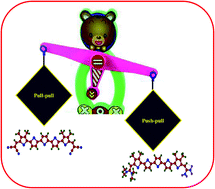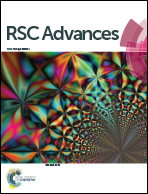A DFT/TDDFT mission to probe push–pull vinyl coupled thiophene oligomers for optoelectronic applications†
Abstract
Vinyl coupled thiophene oligomers (VCTOs) are one of the active components in organic solar cells. In the present study, VCTOs with various acceptor groups (–CN, –NO2 and –COOH) have been considered and their optoelectronic properties have been evaluated using DFT/TDDFT calculations. In total, 17 VCTOs, including 3 already reported, have been considered. The computed results reveal that the reference VCTOs (VCTO1, 2 and 3) can be used as possible electron transport materials, and the newly designed VCTOs are found to be promising hole transport materials. Among these, VCTO4b is found to show a lower band gap, whereas VCTO3c has a higher band gap. Furthermore, the study explores the roles of donor and acceptor groups in the band gap, ionization potential, electron affinity, exciton binding energy and light harvesting efficiency of these VCTOs. The spectral analysis shows that the modelled VCTOs have strong n → π* transitions, while the reference VCTOs were found to show predominant π → π* transitions. In summary, 9 out of 14 of the designed VCTOs were found to show better optoelectronic properties than their reference molecules.


 Please wait while we load your content...
Please wait while we load your content...